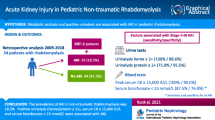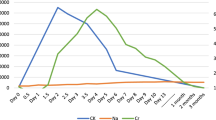Abstract
Rhabdomyolysis (RM) is a potentially fatal or disabling clinical syndrome resulting in muscle necrosis and leakage of muscle constituents into the blood. Lactic acidosis and more serious complications such as acute renal failure may occur in up to half of recognized cases, so accurate diagnosis is required. We present three cases in which RM occurred in patients undergoing neurosurgical procedures performed in the lateral position. A review of the literature is provided together with a framework for the prevention of this surgical complication. Three patients underwent neurosurgical procedures in the lateral position for left facial/glossopharyngeal neuralgia, for jugular foramen tumor, and for a petroclival meningioma, respectively. All patients were obese and all three showed massive postoperative elevation in creatine kinase (CK) levels characteristic of RM. Myoglobinuria was identified in two patients and all three showed hyperintensity of the hip gird muscles in the short tau inversion recovery sequence magnetic resonance imaging. All recovered spontaneously and none went on to develop renal failure. A literature review showed that RM has been rarely reported after neurosurgery. However, the duration of procedures of the cases of reported RM indicates that the prevalence of the condition is likely highly under-recognized in neurosurgery. This is particularly important given the rising obesity rates seen in many countries. Obese patients undergoing long neurosurgical procedures, particularly in the lateral position, should be suspected of RM and should be closely monitored for CK levels, myoglobinuria, and acidosis. We outline a framework of strategies for the prevention of the condition.



Similar content being viewed by others
References
Alterman I, Sidi A, Azamfirei L, Copotoiu S, Ezri T (2007) Rhabdomyolysis: another complication after prolonged surgery. J Clin Anesth 19(1):64–66. doi:10.1016/j.jclinane.2006.06.002
Arts MP, Nieborg A, Brand R, Peul WC (2007) Serum creatine phosphokinase as an indicator of muscle injury after various spinal and nonspinal surgical procedures. J Neurosurg Spine 7(3):282–286. doi:10.3171/SPI-07/09/282
Bocca G, van Moorselaar JA, Feitz WF, van der Staak FH, Monnens LA (2002) Compartment syndrome, rhabdomyolysis and risk of acute renal failure as complications of the lithotomy position. J Nephrol 15(2):183–185
Brown JA (2003) Lateral gluteal myonecrosis in a patient undergoing partial nephrectomy in the modified flank position. Urology 61(2):462
Bruce RG, Kim FH, McRoberts W (1996) Rhabdomyolysis and acute renal failure following radical perineal prostatectomy. Urology 47(3):427–430
Bywaters EG, Beall D (1941) Crush injuries with impairment of renal function. Br Med J 1(4185):427–432
Dakwar E, Rifkin SI, Volcan IJ, Goodrich JA, Uribe JS (2011) Rhabdomyolysis and acute renal failure following minimally invasive spine surgery. J Neurosurg Spine 14(6):785–788. doi:10.3171/2011.2.SPINE10369
Dayer-Berenson L (1994) Rhabdomyolysis: a comprehensive guide. Anna J 21(1):15–18, quiz 19–20
Fabuel Deltoro M, Ramos de Campos M, Juan Escudero J, de la Cruz Torrijos FS, Montoliu Garcia A, Marques Vida E, Navalon Verdejo P (2008) Rhabdomyolysis after laparoscopic nephrectomy: case report. Arch Esp Urol 61(7):823–825
Gabow PA, Kaehny WD, Kelleher SP (1982) The spectrum of rhabdomyolysis. Medicine (Baltimore) 61(3):141–152
Glassman DT, Merriam WG, Trabulsi EJ, Byrne D, Gomella L (2007) Rhabdomyolysis after laparoscopic nephrectomy. Jsls 11(4):432–437
Graham DJ, Staffa JA, Shatin D, Andrade SE, Schech SD, La Grenade L, Gurwitz JH, Chan KA, Goodman MJ, Platt R (2004) Incidence of hospitalized rhabdomyolysis in patients treated with lipid-lowering drugs. Jama 292(21):2585–2590. doi:10.1001/jama.292.21.2585
Haddon W Jr (1968) The changing approach to the epidemiology, prevention, and amelioration of trauma: the transition to approaches etiologically rather than descriptively based. Am J Public Health Nations Health 58(8):1431–1438
Hidou M, Huraux C, Mariot J, Voltz C, Strub P (1993) Rhabdomyolysis after ORL surgery in prolonged lateral position. Ann Fr Anesth Reanim 12(3):329–332
Hiratsuka Y, Ishii T, Takeuchi F, Okadome A, Taira H (2003) Risk of elevated creatine kinase and myoglobulinemia due to incised muscles in patients who underwent urological surgery. J Urol 170(1):119–121. doi:10.1097/01.ju.0000070660.41083.a3
Irvine J, Aho T, Davidson P, Searle M (2006) Rhabdomyolysis following laparoscopic radical nephrectomy: a case to heighten awareness. Nephrology (Carlton) 11(4):282–284. doi:10.1111/j.1440-1797.2006.00578.x
Knochel JP (1993) Mechanisms of rhabdomyolysis. Curr Opin Rheumatol 5(6):725–731
Lin AC, Lin CM, Wang TL, Leu JG (2005) Rhabdomyolysis in 119 students after repetitive exercise. Br J Sports Med 39(1):e3. doi:10.1136/bjsm.2004.013235
Mathes DD, Assimos DG, Donofrio PD (1996) Rhabdomyolysis and myonecrosis in a patient in the lateral decubitus position. Anesthesiology 84(3):727–729
McInnes E, Bell-Syer SE, Dumville JC, Legood R, Cullum NA (2008) Support surfaces for pressure ulcer prevention. Cochrane Database Syst Rev (4):CD001735. doi:10.1002/14651858.CD001735.pub3
Melli G, Chaudhry V, Cornblath DR (2005) Rhabdomyolysis: an evaluation of 475 hospitalized patients. Medicine (Baltimore) 84(6):377–385
Moghtader J, Brady WJ Jr, Bonadio W (1997) Exertional rhabdomyolysis in an adolescent athlete. Pediatr Emerg Care 13(6):382–385
Mognol P, Vignes S, Chosidow D, Marmuse JP (2004) Rhabdomyolysis after laparoscopic bariatric surgery. Obes Surg 14(1):91–94. doi:10.1381/096089204772787356
Moratalla MB, Braun P, Fornas GM (2008) Importance of MRI in the diagnosis and treatment of rhabdomyolysis. Eur J Radiol 65(2):311–315. doi:10.1016/j.ejrad.2007.03.033
Nixon J, McElvenny D, Mason S, Brown J, Bond S (1998) A sequential randomised controlled trial comparing a dry visco-elastic polymer pad and standard operating table mattress in the prevention of post-operative pressure sores. Int J Nurs Stud 35(4):193–203
Ori Y, Korzets A, Gruzman C, Chagnac A, Zevin D, Weinstein T, Herman M, Gafter U (1998) Postoperative rhabdomyolysis in patients with end-stage renal failure. Am J Kidney Dis 31(3):539–544. doi:10.1053/ajkd.1998.v31.pm9506695
Owen CA, Mubarak SJ, Hargens AR, Rutherford L, Garetto LP, Akeson WH (1979) Intramuscular pressures with limb compression clarification of the pathogenesis of the drug-induced muscle-compartment syndrome. N Engl J Med 300(21):1169–1172. doi:10.1056/NEJM197905243002101
Pham B, Teague L, Mahoney J, Goodman L, Paulden M, Poss J, Li J, Sikich NJ, Lourenco R, Ieraci L, Carcone S, Krahn M (2011) Support surfaces for intraoperative prevention of pressure ulcers in patients undergoing surgery: a cost-effectiveness analysis. Surgery 150(1):122–132. doi:10.1016/j.surg.2011.03.002
Poels PJ, Gabreels FJ (1993) Rhabdomyolysis: a review of the literature. Clin Neurol Neurosurg 95(3):175–192
Poli D, Gemma M, Cozzi S, Lugani D, Germagnoli L, Beretta L (2007) Muscle enzyme elevation after elective neurosurgery. Eur J Anaesthesiol 24(6):551–555. doi:10.1017/S0265021506002389
Reisiger KE, Landman J, Kibel A, Clayman RV (2005) Laparoscopic renal surgery and the risk of rhabdomyolysis: diagnosis and treatment. Urology 66(5 Suppl):29–35. doi:10.1016/j.urology.2005.06.009
Sauret JM, Marinides G, Wang GK (2002) Rhabdomyolysis. Am Fam Physician 65(5):907–912
Slater MS, Mullins RJ (1998) Rhabdomyolysis and myoglobinuric renal failure in trauma and surgical patients: a review. J Am Coll Surg 186(6):693–716
Takahashi N, Shimada T, Tanabe K, Yoshitomi H, Murakami Y, Ishibashi Y, Kikkawa R, Yano S, Araki A, Inoue A (2011) Steroid-induced crisis and rhabdomyolysis in a patient with pheochromocytoma: a case report and review. Int J Cardiol 146(2):e41–e45. doi:10.1016/j.ijcard.2008.12.183
Van Gompel JJ, Khan YA, Bloomfield EL, Pallanch JF, Atkinson JL (2009) Rhabdomyolysis after transnasal repair of anterior basal encephalocele. Surg Neurol 72(6):757–760. doi:10.1016/j.surneu.2009.05.015
Visweswaran P, Guntupalli J (1999) Rhabdomyolysis. Crit Care Clin 15(2):415–428, ix–x
Weber B, Todd G, Moore RB (2008) Rhabdomyolysis following renal autotransplantation. Can Urol Assoc J 2(1):57–60
Whitesides TE, Haney TC, Morimoto K, Harada H (1975) Tissue pressure measurements as a determinant for the need of fasciotomy. Clin Orthop Relat Res 113:43–51
Williams JE Jr, Tucker DB, Read JM 3rd (1983) Rhabdomyolysis–myoglobinurea: consequences of prolonged tourniquet. J Foot Surg 22(1):52–56
Zager RA (1996) Rhabdomyolysis and myohemoglobinuric acute renal failure. Kidney Int 49(2):314–326
Conflict of interest
The authors report no conflict of interest concerning the materials or methods used in this study or the findings specified in this paper.
Author information
Authors and Affiliations
Corresponding author
Additional information
Comments
Andreas M. Stark, Kiel, Germany
Rhabdomyolysis is a rare but serious complication of trauma, surgery, intoxication, hyperthermia, extreme exercise, and other conditions. The authors report three interesting cases of RM following neurosurgical procedures in three obese patients operated in the lateral position. They point well to this problem and discuss strategies to prevent RM. We personally have good experience in using the supine position with the patient’s head turned in obese individuals, also to prevent RM.
Ignacio J. Previgliano, Buenos Aires, Argentina
Dr. De Tomasi and Cusimano’s review address an important and almost forgotten cause of acute kidney failure in the intensive care unit: rhabdomyolysis (RM).
In their comprehensive research, they identify obesity as the main factor to develop RM, added to lateral decubitus and more than 6 h of surgery duration. Szeeczyk1 et al. promoted reperfusion of damaged tissue after prolonged ischemia, probably due to changes in muscular pressure that overlap mean arterial pressure during anesthesia, and the secondary release of necrotic products and mediators to the bloodstream after these excess of pressure is alleviated. The most common positions related with RM were lateral decubitus, lithotomy, sitting, knee-to-chest and prone position, added to increased body mass index, duration of surgery, hypovolemia, uremia, diabetes and arterial hypertension.2
Although there is a long list of genetic disorders and drugs that can cause RM, I will like to remain some of them that are related to the perioperative period.
One group of drugs is statins. They are commonly used not only for their cholesterol-lowering properties but for it pleiotropic effect. Developing RM seems to be a drug class effect because it was described with most of statins.3,4,5,6
Cocaine abuse either chronic or recreational is associated with RM.7 As its use is extended worldwide (according to Argentine Drug Abuse Office, 2.6 % of Argentinean adults consume cocaine8), this act should be attend during anamnesis.
One should never forget anesthetics drugs as a source for RM. Neuroleptic malignant syndrome, propofol infusion syndrome, opioids, and some inhalatory agents derived from halothane (malignant hyperthermia). The caffeine/halothane test is very useful to identify patients at risk for malignant hyperthermia.9
Although it extended use, there is little evidence to recommend urine alkalinization or mannitol for RM treatment.10 So the most reliable treatment lays on volume expansion according central venous pressure in order to maintain urine output near 100–150 ml/h.11
References
1. Szewczyk D, Ovadia P, Abdullah F, et al. Pressure induced rhabdomyolysis and acute renal failure. J Trauma 1998;44:384.
2. Biswas S, Gnanasekaran I, Ivatury RR, et al. Exaggerated lithotomy position-related rhabdomyolysis. Am Surg. 1997;63:361–364.
3. Jose J, Saravu K, Shastry BA. Atorvastatin-induced early-onset rhabdomyolysis in a patient with nephritic syndrome. Am J Health Syst Pharm. 2007;64:726–729.
4. Sylvain-Moore H, Worden JP. Lovastatin-induced rhabdomyolysis. Heart Lung. 1991;20:464–466.
5. Rosenberg AD, Neuwirth MG, Kagen LJ, Singh K, Fischer HD, Bernstein RL. Intraoperative rhabdomyolysis in a patient receiving pravastatin, a 3-hydroxy-3-methyglutaryl coenzyme A (HMG Co A) reductase inhibitor. Anesth Analg. 1995;81:1089–1091.
6. Khan FY, Ibrahim W. Rosuvastatin induced rhabdomyolysis in a low risk patient: a case report and review of the literature. Curr Clin Pharmacol. 2009;4:1–3.
7. Dinis-Oliveira RJ, Carvalho F, Duarte JA, Proença JB, Santos A, Magalhães T. Clinical and forensic signs related to cocaine abuse. Curr Drug Abuse Rev. 2012;5:64–83.
8. Secretaría de Programación para la Prevención de la Drogadicción y la Lucha contra el Narcotráfico—Presidencia de la Nación. Available at www.sedronar.gov.ar. Accessed 8 June 2012
9. Larach MG. Standardization of the caffeine halothane muscle contracture test. North American Malignant Hyperthermia Group. Anesth Analg. 1989 Oct;69:511–515.
10. Thomas R. Towards evidence based emergency medicine: best BETs from the Manchester Royal Infirmary. Bet 1. Rhabdomyolysis and the use of sodium bicarbonate and/or mannitol. Emerg Med J. 2010 Apr;27(4):305–308.
11. Parekh R, Care DA, Tainter CR. Rhabdomyolysis: advances in diagnosis and treatment. Emerg Med Pract. 2012;14:1–15
Rights and permissions
About this article
Cite this article
De Tommasi, C., Cusimano, M.D. Rhabdomyolysis after neurosurgery: a review and a framework for prevention. Neurosurg Rev 36, 195–203 (2013). https://doi.org/10.1007/s10143-012-0423-0
Received:
Revised:
Accepted:
Published:
Issue Date:
DOI: https://doi.org/10.1007/s10143-012-0423-0




